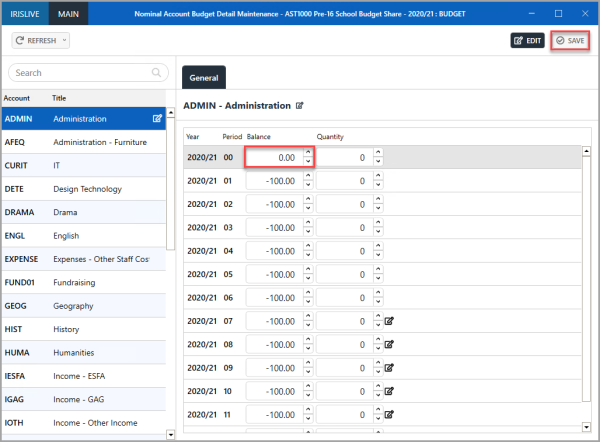Creating a Budget Framework
Some Of the nominals and ledgers used in this topic may be different to those in your chart of accounts.
Budgets are used to record estimations of income and expense based on future plans and objectives. Reports can be subsequently produced to compare the budget against actual performance in order to establish variances and if required, take remedial action.
It is generally considered good practice to review budgets from previous years and compare which figures were estimated accurately, which costs went over-budget and which, if any, were under-spent. This helps to ensure that the budget is as accurate as possible.
Budgets can be created manually or can be imported. This topic explains how to create your budget structure in IRIS Financials and manually add budget values to the system.
You can also import a budget, for more information, please see Importing Budgets.
Before you Start
Before adding a new budget, you have two options:
-
Create a new budget code - This adds a new budget code to the system. This could also be used as a revised budget or a forecast that you can then use as a comparison to the initial budget for the year.
-
Update and add to an existing budget code - You can use the same budget code year on year. This is useful if you do not want numerous budget codes within the system and also reduces the additional need to change the default budget within IRIS Purchasing at the start of each year.
We would recommend that the initial budget for each year should be added to a master budget code, typically the existing budget code can be used. The same code can be used each year as the budget is saved against both a budget code and a year.
The following section advises how to create a new budget code, but if you are going to use an existing budget code you can go straight to Manually Entering Budget Values.
If the year and period do not exist you are not able to create a budget for them. Check that the year/periods you are going to enter the budget for have been set up. To view and add any required year/periods for the budget, select Maintenance, then select Periods from the menu. For more information, please see Manually Adding Accounting Periods.
Creating a Budget Code
-
Select Maintenance, then select Budgets from the menu.
-
The Budget Maintenance window is displayed, containing any existing budget codes in the left-hand panel. To add a new budget select ADD NEW, then select BUDGET.
If the new budget has the same settings applied to an existing budget, select the required budget from the left-hand panel, select ADD NEW, then select BUDGET (COPY) to create the new budget. -
Enter a code (limited to 12 characters) in Budget, and title to help identify the budget in Title, then select SAVE. (If you are entering a transactional budget, select Transactional).
Do not use any spaces or special characters in the code for the budget. The code must be in all capitals and/or numbers e.g. BUDGETV2.You do not need to create a new code for each year as budgets are saved against both a budget code and a year.
By default, the Access level for a budget is set to 3. If you want to restrict access to the budget, you can increase this. To change the Access Level, overwrite or use the up-down buttons to select the required access level.
Manually Entering Budget Values
-
Select Maintenance, then select Nominal Budget Details from the menu.
-
The Nominal Budget Detail Maintenance window is displayed, check the blue header row to see which budget code and year is being displayed. If necessary, use CHANGE YEAR and CHANGE BUDGET to select the budget code and year that you want to populate.
-
Budgets may be applied to several different ledger accounts (cost centres) on the same nominal. It is not possible to set the budget value at nominal level only. Select the nominal you want to add the budget to, then select ACCOUNTS.

-
The Nominal Account Budget Detail Maintenance window is displayed, listing the ledger accounts (cost centres) in the left-hand panel. Select the required account, then select EDIT.
Income must be entered with a minus figure as these are credit values. For example, -1,000 shows an income against the specified nominal and account. Expenditure is entered as a debit value. -
Enter the budget values for each period for the selected nominal and account in the Balance column. When all the required budget details have been entered, select SAVE. Repeat the process for all nominals and accounts required.

There is a BudgetMatrix report in the Reporting Suite, which shows an overview of the the budget against any budget code. You can review this at any time to see what the budget looks like. To view the Budget Matrix report, select Modules, then select ReportingSuite from the menu, then select the BudgetMatrix report from the General Reports panel.